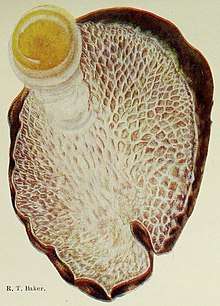Laccocephalum mylittae
Laccocephalum mylittae, commonly known as native bread or blackfellow's bread, is an edible Australian fungus. The hypogeous fruit body was a popular food item with Aboriginal people.
| Laccocephalum mylittae | |
|---|---|
 | |
| Reproduction of a watercolour made by R. T. Baker, of the Laccocephalum mylittae sporophore | |
| Scientific classification | |
| Kingdom: | |
| Division: | |
| Class: | |
| Order: | |
| Family: | |
| Genus: | |
| Species: | L. mylittae |
| Binomial name | |
| Laccocephalum mylittae | |
| Synonyms | |
|
Polyporus mylittae Cooke & Massee (1892) | |
| Laccocephalum mylittae | |
|---|---|
float | |
| ecology is saprotrophic | |
| edibility: edible | |
It was originally described as Polyporus mylittae by Mordecai Cubitt Cooke and George Edward Massee in 1893, before being placed in the small genus Laccocephalum by María Núñez and Leif Ryvarden in 1995.
The bumpy whitish cap has wavy margins and sprouts from an underground stipe. It grows in rainforests and eucalyptus forest. The stipe is attached to a large underground fruit body that Aborigines regarded as a delicacy.[1] The Nyungar people commonly consumed the species, which became available in large quantities after fire in karri forest.[2]
Recorded from areas around Perth and from states in southeastern Australia, Laccocephalum mylittae, is a large, edible – though not particularly tasty – fungus that grows in rainforest and eucalypt forests. Fungimappers at the Sunnybrae Restaurant in Birregurra, Victoria tried a variety of ways to cook a specimen from the Otways in 2008.[3]
References
- Low, T., Wild Food Plants of Australia, Angus & Robertson, 1992, ISBN 0-207-16930-6
- Turney, Chris S. M.; Bird, Michael I.; Fifield, L. Keith; Roberts, Richard G.; Smith, Mike; Dortch, Charles E.; Grün, Rainer; Lawson, Ewan; Ayliffe, Linda K.; Miller, Gifford H.; Dortch, Joe; Cresswell, Richard G. (20 January 2017). "Early Human Occupation at Devil's Lair, Southwestern Australia 50,000 Years Ago". Quaternary Research. 55 (01): 3–13. doi:10.1006/qres.2000.2195.
- http://fungimap.org.au/index.php/learn-about-fungi/poisonous-fungi